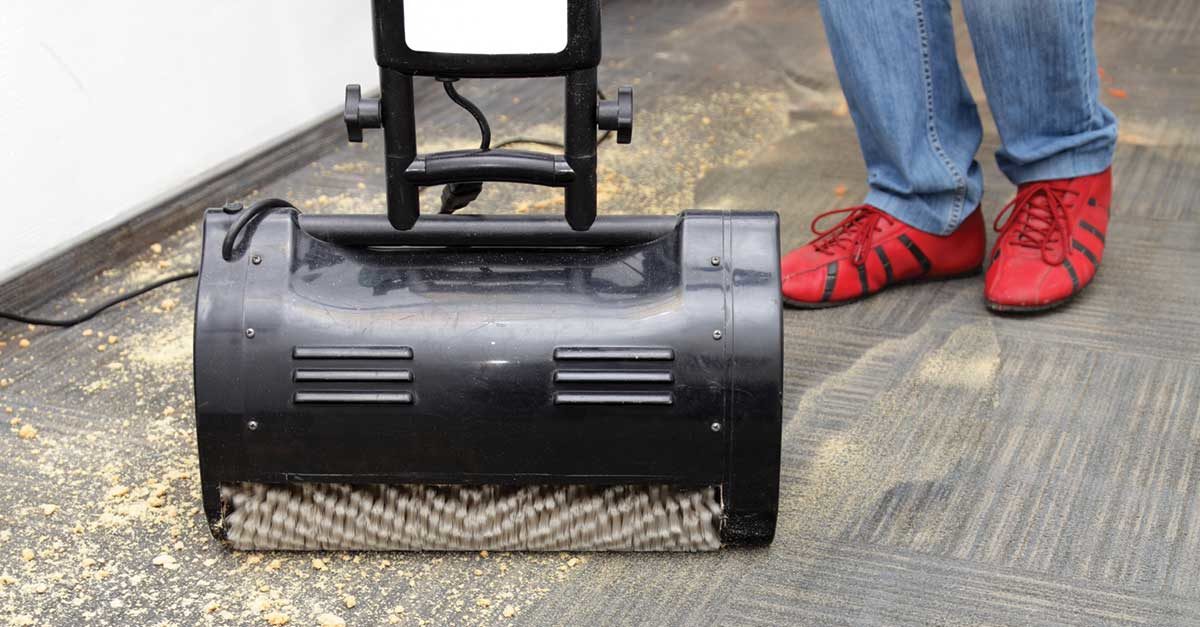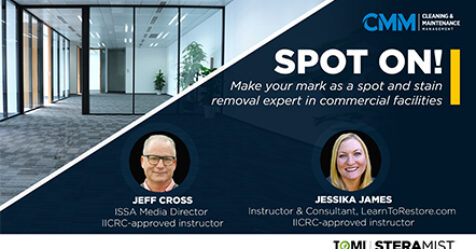Dry absorbent compound has earned a rightful place in interim carpet care. It dries within a few minutes and produces an impressive carpet appearance. Interim, or low-moisture cleaning processes are effective in carpet appearance retention programs.
However, we must carefully examine statements that embellish the outcomes. An article on absorbent compounds published in CMM stated, “The absorbent compound cleaning method can perform deep restorative cleaning as well as, if not better than, other methods”
What Is a Deep Restorative Cleaning Process?
Many dictionaries explain that a restorative process is to, “bring back to, or put back into a former or original state.” Cleaning carpet using counter-rotating brushes with an absorbent compound has its limitations. This method lacks the ability to fully reach the base of the carpet; the inside fibers of a looped carpet; or to rinse, flush, and recover embedded soil, liquid contaminates, and 100% of the compound.
Here is a test that will display comparative results when cleaning with brushes and absorbent compound. Firmly press and slightly agitate a damp white terrycloth towel deep into a carpet recently cleaned with absorbent compound. The process will transfer and display a noticeable dark soil that was not removed from the carpet.
Now, perform the same test on a carpet that was thoroughly extracted with hot water. If the carpet is heavily soiled, vacuum, pre-spray, agitate, and then rotary extract until the recovery water is clear. Using the same blotting/agitating procedure, the towel will not display noticeable soil.
A second test involves a repeat of the hot water extraction process, so the carpet is cleaned twice. When finished with the second cleaning, drain some of the recovery water into a glass beaker. It should be only slightly cloudy.
Next, hot water extract a carpet that was just cleaned with the absorbent compound and observe the soiled, dark recovery effluent. You might call this a day and night comparison.
These comparisons confirm that the absorbent compound process was insufficient in performing a deep restorative cleaning.
Cleaning Homes and Health Care Facilities
Having worked with many hospitals, I know there is a concern about flushing blood, body fluids, and bio-contaminates from the base of the carpet. Since some patients walk the carpeted halls bare-footed, hospitals endeavor to flush and extract harmful contaminates.
Likewise, home owners with pets and children notice the difference in removing pet accidents from the base of the carpet by flushing and rinsing. Whereas, surface brushing to clean only the top accessible portions of the carpet can leave embedded residue.
Earning the CRI Seal of Approval
The Carpet and Rug Institute has developed a comprehensive testing protocol to approve carpet-cleaning machines, chemicals, and systems. As a general rule, interim cleaning process are considered low moisture.
CRI defines interim maintenance as a procedure conducted between extraction cleanings designed to improve carpet appearance without significantly limiting occupant usage.
To date, about 89 deep cleaning extractors have received the CRI seal of approval, all of which use hot water extraction. Absorbent powder has been granted a silver rating under the cleaning systems category, with a 70% to 79% soil removal rating.
Numerous machines and processes have been CRI-certified with a platinum rating, which requires a 90% to 100% soil removal rating. Simple math confirms the difference between a silver and platinum rating, with the platinum rating showing about a 25% improvement.
For cleaning professionals concerned with the inhalation of harmful fumes from hot-water extraction chemicals, the Safer Choice EPA program certifies cleaning solutions that contain no harmful ingredients. The Green Seal program likewise certifies carpet extraction products that are safe, many of which are bio-based. So, there is a plethora of safe extraction products to choose from.
In conclusion, many facilities prefer using the interim low-moisture cleaning process to maintain carpet appearances. However, they realize the added benefit of a periodic, deep, hot-water extraction to flush out accumulating soil and cleaning solutions from the unseen base of the carpet.




